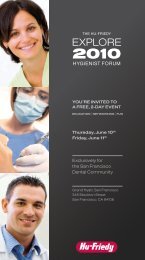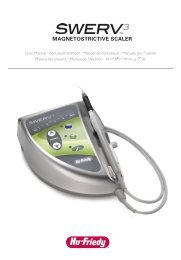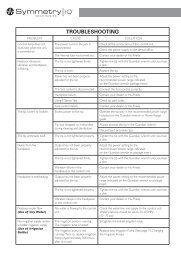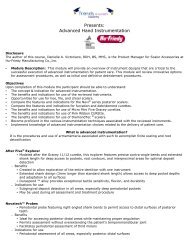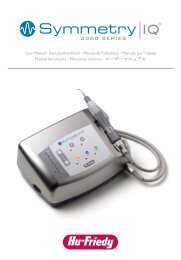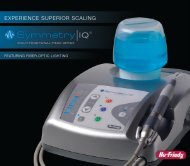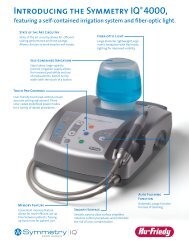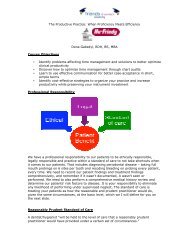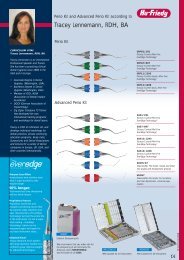Effective and Productive Instrument Processing - Friends of Hu-Friedy
Effective and Productive Instrument Processing - Friends of Hu-Friedy
Effective and Productive Instrument Processing - Friends of Hu-Friedy
Create successful ePaper yourself
Turn your PDF publications into a flip-book with our unique Google optimized e-Paper software.
educe the risk <strong>of</strong> microbial transmission in the dental setting.<br />
The goal <strong>of</strong> each <strong>of</strong> the four basic principles is to break one or<br />
more links in the chain <strong>of</strong> infection. 5<br />
St<strong>and</strong>ard precautions<br />
Universal precautions were created in the 1980s to help protect<br />
against bloodborne disease transmission. In dentistry, these include<br />
h<strong>and</strong> washing; use <strong>of</strong> PPE such as gloves, eyewear <strong>and</strong> face<br />
protection; <strong>and</strong> recommendations for proper h<strong>and</strong>ling <strong>of</strong> patient<br />
care items <strong>and</strong> contaminated surfaces. As the word “universal”<br />
suggests, the precautions are applied when treating all patients, regardless<br />
<strong>of</strong> health history or presumed risk <strong>of</strong> bloodborne disease.<br />
In the mid-1990s, the term “st<strong>and</strong>ard precautions” was introduced.<br />
While universal precautions focus mainly on preventing<br />
exposure to blood, st<strong>and</strong>ard precautions guard against exposure to<br />
all body fluids (except sweat, which is not considered infectious). 6<br />
In the dental setting, there is little practical difference between<br />
universal <strong>and</strong> st<strong>and</strong>ard precautions. All <strong>of</strong> the precautions traditionally<br />
used to protect against blood <strong>and</strong> blood-contaminated<br />
saliva also protect against exposure to any other fluids that would<br />
typically be encountered in the dental setting. The DHCP should<br />
treat every patient as if he or she could be a source <strong>of</strong> infection.<br />
Using st<strong>and</strong>ard precautions limits cross-contamination <strong>and</strong><br />
cross-infection. 7,8 Single-use surface barriers such as plastic wrap or<br />
sheaths prevent contamination <strong>of</strong> surfaces. 9 These barriers should<br />
be used on as many surfaces as possible, <strong>and</strong> especially on surfaces<br />
that are difficult to access or disinfect (such as X-ray tubes). The<br />
use <strong>of</strong> barriers is reliable, saves time <strong>and</strong> reduces exposure to<br />
chemicals. 10 Clinical contact surfaces that do not have barrier covers<br />
or become contaminated during removal <strong>of</strong> the barrier require<br />
surface disinfection. Disinfection should be carried out using an<br />
EPA-registered disinfectant with tuberculocidal activity (i.e.,<br />
CDC intermediate-level disinfectant) or a low-level disinfectant.<br />
Personnel <strong>and</strong> patients rarely come in contact with housekeeping<br />
surfaces. These require regular cleaning to remove soil <strong>and</strong> dust.<br />
These areas include floors, walls <strong>and</strong> some countertops. Cleaning<br />
should include use <strong>of</strong> an EPA-registered hospital disinfectant with<br />
no tuberculocidal activity (i.e., CDC low-level disinfectant) or an<br />
intermediate-level disinfectant if blood is visible.<br />
Figure 1. Disinfection <strong>of</strong> Surfaces<br />
Surface<br />
Type<br />
Clinical contact<br />
surfaces<br />
Housekeeping<br />
surfaces<br />
Single-use<br />
barrier covers<br />
CDC intermediate-level<br />
or low-level disinfectant<br />
No blood present<br />
Blood present<br />
+ disinfectant if surface<br />
contaminated<br />
CDC low-level<br />
disinfectant<br />
CDC intermediate-level<br />
disinfectant<br />
In summary, with vaccination; appropriate h<strong>and</strong> hygiene; careful<br />
h<strong>and</strong>ling <strong>of</strong> sharp items; use <strong>of</strong> barrier techniques; <strong>and</strong> proper<br />
cleaning, disinfection <strong>and</strong> sterilization procedures, you can meet<br />
many requirements for a safe workplace. <strong>Instrument</strong> processing<br />
is a key component <strong>and</strong>, when performed appropriately, breaks<br />
the chain <strong>of</strong> infection, reduces DHCP stress, improves productivity<br />
<strong>and</strong> staff safety, <strong>and</strong> results in cost savings.<br />
<strong>Instrument</strong> <strong>Processing</strong> <strong>and</strong> Infection Control<br />
After the patient is dismissed, the operatory must be prepared<br />
for the next patient, including the treatment <strong>of</strong> surfaces <strong>and</strong><br />
instrument processing. This process must be performed correctly<br />
every time to ensure items are properly processed. Having<br />
working, organized, sharp, debris-free <strong>and</strong> sterile (or disposable)<br />
instruments aids in the <strong>of</strong>fice’s production, the quality <strong>of</strong><br />
dentistry, <strong>and</strong> the safety <strong>of</strong> patients <strong>and</strong> staff. Quality sterile<br />
dental instruments are key to the practice <strong>of</strong> dentistry. Choosing<br />
a system that minimizes risk, maximizes productivity <strong>and</strong> saves<br />
money is important. In addition, while some instruments must<br />
be disposable, limiting the disposal <strong>of</strong> reusable devices helps<br />
keep the world greener. Using instrument cassettes minimizes<br />
DHCP contact with contaminated instruments, organizes the<br />
instruments for safe <strong>and</strong> efficient processing, keeps the instruments<br />
free from debris, protects instruments from damage <strong>and</strong><br />
helps instruments remain sterile after processing. Sterilization<br />
cassettes also st<strong>and</strong>ardize procedural setups by organizing the<br />
instruments by procedure or type <strong>of</strong> user. This st<strong>and</strong>ardization<br />
enables any staff member to quickly identify the proper cassette<br />
for every procedure. Cassettes help eliminate lost instruments<br />
during instrument processing or transportation to <strong>and</strong> from the<br />
operatory. Dr. Lou Graham found that by creating st<strong>and</strong>ardized<br />
setups <strong>and</strong> using the cassette system in his <strong>of</strong>fice, his staff saved<br />
an average <strong>of</strong> five minutes per procedure, which allowed the staff<br />
to spend more time with patients <strong>and</strong> contributed to productivity<br />
<strong>and</strong> therefore revenue generation. 11 <strong>Instrument</strong> processing<br />
requires consideration <strong>of</strong> the necessary equipment, workflow <strong>and</strong><br />
stages involved. In general, the processing can be divided into a<br />
chairside component <strong>and</strong> a processing area component.<br />
Having organized, sharp, <strong>and</strong> sterile (or disposable) instruments<br />
aids in production, the quality <strong>of</strong> dentistry, <strong>and</strong> safety.<br />
Chairside Procedure<br />
Single-use disposable instruments<br />
These are designed to be used only once - for one patient <strong>and</strong><br />
discarded appropriately. They cannot be cleaned, disinfected<br />
or sterilized. These include blades, needles, prophylaxis angles,<br />
carpules, cups <strong>and</strong> brushes, evacuator tips, saliva ejectors, <strong>and</strong><br />
air/water syringe tips. 3 These items are becoming more <strong>and</strong><br />
more available <strong>and</strong> economical. They eliminate the chance <strong>of</strong><br />
cross-contamination, the need for extensive postoperative h<strong>and</strong>ling<br />
(with a risk <strong>of</strong> sharps injuries) <strong>and</strong> exposure to sterilization<br />
chemicals. Disposing <strong>of</strong> all single-use items immediately after<br />
treatment limits the risk <strong>of</strong> sharps injuries.<br />
The CDC recommends that there be a sharps container in every<br />
room in which treatment is delivered. Placing sharps in the<br />
container as soon as possible eliminates the hazard quickly.<br />
www.ineedce.com 3



